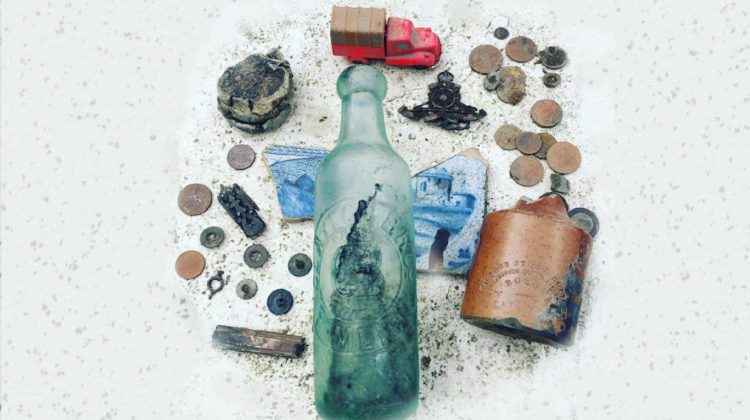
Anyone live near to the water where the mudlarks build their bowl-like nests of soft mud and then line them with feathers? Sometimes called Pee Wees, mudlarks are fairly large black and white flycatchers which are called Magpie-larks in Australia.
We have no idea when or by whom the mudlark name was first applied to paupers in London. However, we can’t think of a more appropriate name. We do know that in Victorian England the poorest children scavenged all along the River Thames foreshore or “beach”.
Muddy Treasures
The black mud on the beach is stinky, sticky, and oxygen-free, which means that there is no air in it. It preserves leather, metal, glass, and ceramic for centuries. The desperately poor, both children and adults, searched for coins, lumps of coal, traders tokens, rags, buckles, bits and bobs off ships and boats, and anything else that they could use or sell for a few pence.
And there is lots to be found! For example, in Greenwich, a district in south London there is a nearly 600-year-old garbage dump at the former site of Placentia Palace. Even today modern mudlarks pull all sorts of treasures out of the dump.
Staying Alive
There were many different coins in circulation In Victorian London. A farthing was ¼ penny or pence. A pence is written d for denarius from the Roman coin of the same name. Twelve pence made one shilling; 20 shillings made one pound (₤). There were also half-sovereigns, crowns, and guineas. Needless to say, modern mudlark hobbyist find all these coins and many others.
The Victorian mudlarks may have found coins, too, but they exchanged their other finds for money and then they used the coins to buy food and shelter. Meat at the time cost about 4 shilling. We have no idea what kind of meat nor how much you got for this price. Ten loaves of bread would set you back two shilling 3.5d. Tea, and again we have no idea how much, was about 1shilling while candles cost 1d.
Modern Mudlarking: Crazy Like a Fox
Some time back we learned about modern-day mudlarking on the Thames River and especially in London. A great place to see some finds is at Tideline Art which has a section, with one marble, called “Lost Toys and Figurines.” We also learned about Lara Maiklem’s book Mudlark: In Search of London’s Past Along the River Thames. London: W.W. Norton, 2019.

Lara manages to capture the awe and history of the dig. She has fascinating back stories for many of her finds. We know exactly how she feels when she digs because we felt the same fascination when we explored the deserts in Southwest Asia.
Her knowledge of the Thames and the various districts where she searches is astounding. And her book often reads like an adventure novel. We were totally spooked, for example, when she reported her searches along the Thames Estuary around Lower Hope Point. We do not trust those tides! In addition to Maiklem, there are at least three other modern mudlark books on the market.
Do you have a permit for that?
The port authority for London is cracking down; permits are now required. This includes all searching, metal detecting, beachcombing, scraping and digging. They require special permits for specific for specific areas. New permits were not being issued just about the Pandemic settled in. No new permits were being issued in 2021.
Anyone can look along the foreshore, but the exact number of inches you can scrape is prescribed by law. A mudlark permit is only issued after two years of looking. The permits are expensive at 90₤ and they limit what a person can do in their search. The permits also spell out exactly how deep the holder can dig! There are also rules for what are considered archaeological finds and treasure. Still mudlarking has become a multi-million pound industry as well as a media frenzy.
Ever find any Mudlark Marbles?
While learning all this, somewhere along the way, we discovered some glass marbles found along the foreshore. We wanted some! We wrote to a museum or two as well as to some hobby groups of mudlarks.
Finally, we found Simon Bourne who is a graphic designer in London.
“Alright Mudlovers! I’m Si, and you may have seen my YouTube channel ‘Si-finds’. I’m a member of The Thames Society of Mudlarks and when I’m Mudlarking on the River Thames foreshore I often find broken bottles that others have left behind – deemed not good enough to collect – so I rescue and upcycle these bottles so they can live a new life as candle holders, desk tidys or anything else you can think of to put in them.”From Si’s YouTube channel “Si-finds”
The Marbles that we bought from a Mudlark!

To tell you the truth, there are not as many marbles found as you might expect. We corresponded on Etsy and Simon sent us a photograph of some marbles which he has found on the foreshore. It was exciting for us to see that he had not only glass, but stone and clay as well.
We worked it out to use PayPal and Simon even paid the packing and shipping! Stone and Mineral Marbles. The variety of marbles made us very happy. In the top right of the photograph above is a dark stone marble. It is almost certainly German and made from shale.
Aside from Agate, the only stones known to have been used to produce marbles in any significant quantity are Limestone and Shale. These were produced extensively in both Germany and the United States. Production in Germany can be traced as far back as the late 1700s.”Shale Photography & Text
One of the Largest Mudlark Marbles
Next in a row is a glass marble which is shooter size at about ⅞”. This is one of our largest mudlark marbles. This old glass shooter appears to be a German naked core swirl. However, it is badly worn by the Thames so it is really impossible to say for sure. The marble could also be a Cat’s Eye and the swirl in the center may actually be vanes. Exactly what is the difference between internal vanes and swirls?
At the top of the photo is a ball clay or kaolin marble. The marble is about 1” and it very lightweight. We are confident that this marble is British and possibly home made.
The primary china clay (kaolin) deposits of south-west England are world class in terms of their size and quality. They have yielded over 165 million tonnes of marketable clay since production began in the middle of the 18th Century.”Evidence Report: China Clay

Home Made Marbles
The low prices for marbles in the late 19th century were astounding, and they were sometimes home-made from ball, china, or kaolin clay which was rolled and baked. At the bottom is a player (⅝”) blue Cat’s Eye. This one dates to the 1950s and probably is Japanese, but possibly also from Taiwan.
Beside this blue Cat’s Eye is a Codd bottle marble. It is glass, soda-bottle green, and made in a 2-piece mold. While Codd bottles are still manufactured and used in India and Japan, they were most popular in England from 1872. We were very pleased that the Codd bottle marble was included with this lot. It is as deeply rooted in England as ball clay and it would have been a shame should it not be represented.
The last marble in the lot is German cane-cut. It is blue with a polished pontil on both hemispheres. It is called a mellonball.
We really know very little about the production of these mellonballs, other than that they were cut from canes.” Paul Baumann in Collecting Antique Marbles Identification and Price Guide, 4th Ed. pages 90 – 91
We cannot really imagine what an opaque blue cane looked like and we wonder who made the cane. All mellonballs (or melon balls) are somewhat rare and we believe that this one probably dates to about 1870 – 1910.
Mudlark Marbles in Wapping
Simon found our marbles in Wapping which was once a dock area. We placed photographs in a display box with our marbles to remind us where they were found.

Today Wapping is very chic and an excellent place to visit a pub and watch the River. However, the area
…was first mentioned in around 1220 when it was little more than a settlement on the banks of the river. The construction of the wharf in 1395 was when the settlement began to grow and became known as Wapping-on-the-Woze (mud) in the 15th century. During the mid-1500’s the hamlet grew and became the Wapping we know today.” The History of Wapping in East London
We can only imagine what other treasures mudlarks find here!
Let’s Do it again!
Simon offered to set some more marbles aside for us should we ever decide that we want more. Of course, it would be a grab bag again since no one knows what they will find next! We would love to go mudlarking on the Thames. But since we are too old for such a contact sport we will settle on waiting and watching and who knows when we will place our next order!

Want to read more about marbles?

